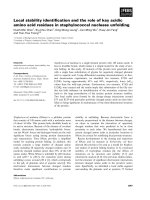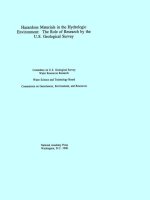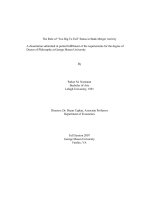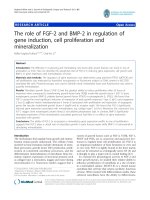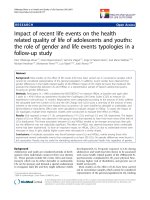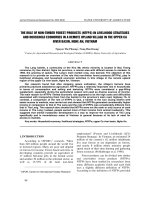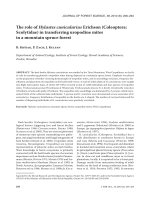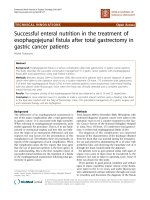The role of chemoprevention by selective cyclooxygenase-2 inhibitors in colorectal cancer patients - a population-based study
Bạn đang xem bản rút gọn của tài liệu. Xem và tải ngay bản đầy đủ của tài liệu tại đây (425.87 KB, 10 trang )
Yang et al. BMC Cancer 2012, 12:582
/>
RESEARCH ARTICLE
Open Access
The role of chemoprevention by selective
cyclooxygenase-2 inhibitors in colorectal cancer
patients - a population-based study
Yi-Hsin Yang1,2, Yea-Huei Kao Yang3*, Ching-Lan Cheng3, Pei-Shan Ho2,4 and Ying-Chin Ko5,6,7
Abstract
Background: There are limited population-based studies focusing on the chemopreventive effects of selective
cyclooxygenase-2 (COX-2) inhibitors against colorectal cancer. The purpose of this study is to assess the trends and
dose–response effects of various medication possession ratios (MPR) of selective COX-2 inhibitor used for
chemoprevention of colorectal cancer.
Methods: A population-based case–control study was conducted using the Taiwan Health Insurance Research
Database (NHIRD). The study comprised 21,460 colorectal cancer patients and 79,331 controls. The conditional
logistic regression was applied to estimate the odds ratios (ORs) for COX-2 inhibitors used for several durations
(5 years, 3 years, 1 year, 6 months and 3 months) prior to the index date.
Results: In patients receiving selective COX-2 inhibitors, the OR was 0.51 (95% CI=0.29~0.90, p=0.021) for an
estimated 5-year period in developing colorectal cancer. ORs showing significant protection effects were found in
10% of MPRs for 5-year, 3-year, and 1-year usage. Risk reduction against colorectal cancer by selective COX-2
inhibitors was observed as early as 6 months after usage.
Conclusion: Our results indicate that selective COX-2 inhibitors may reduce the development of colorectal cancer
by at least 10% based on the MPRs evaluated. Given the limited number of clinical reports from general
populations, our results add to the knowledge of chemopreventive effects of selective COX-2 inhibitors against
cancer in individuals at no increased risk of colorectal cancer.
Keywords: Chemoprevention, Colorectal cancer, Selective COX-2 inhibitor, Population-based study
Background
Colorectal cancer (CRC) is currently a common cancer
in many countries [1]. In Taiwan it is the second leading
cause of cancer-related death, with a 5-year survival rate
of 56% and a median age of 68 years [2]. The incidence
of CRC is a global health problem, and the search for
chemopreventive agents to inhibit its carcinogenesis is
urgently required.
Cyclooxygenase-2 (COX-2) has been found to be overexpressed in a number of cancers, including CRC, and
has been shown to stimulate tumorigenic pathways [3,4].
Therefore, COX-2 is a valid target for inhibiting or
* Correspondence:
3
Institute of Clinical Pharmacy and Pharmaceutical Sciences, Health Outcome
Research Center, National Cheng Kung University, Tainan, Taiwan
Full list of author information is available at the end of the article
preventing carcinogenesis [3,5]. Non-steroidal antiinflammatory drugs (NSAIDs) inhibit both isoforms of
cyclooxygenase (COX-1 and COX-2). In the gastrointestinal tract, COX-1 produces prostanoids that are
involved in the defense and repair of the gastrointestinal
mucosa, while COX-2 is expressed in response to inflammatory stimulation [3]. Variation in the chemical
structure of existing NSAIDs results in different
specificities for COX-1 and COX-2 [6]. Traditional
NSAIDs, such as aspirin, are generally less selective for
COX-2, whereas Coxibs (celecoxib, rofecoxib) have
higher COX-2 selectivity. Given the different roles of
COX enzymes in the gastrointestinal tract, selective
COX-2 inhibitors have been shown to have less gastrointestinal toxicity than traditional NSAIDs [4].
© 2012 Yang et al.; licensee BioMed Central Ltd. This is an Open Access article distributed under the terms of the Creative
Commons Attribution License ( which permits unrestricted use, distribution, and
reproduction in any medium, provided the original work is properly cited.
Yang et al. BMC Cancer 2012, 12:582
/>
Page 2 of 10
Most clinical studies investigating the chemopreventive role of selective COX-2 inhibitors have been conducted in Western populations [7]. Therefore, it is of
interest to conduct similar population-based studies in
an Asian population so that comparisons among demographic groups can be made. The Taiwan Health Insurance Research Database (NHIRD) contains all health
insurance claims made in the Taiwanese population,
serving as a useful resource to conduct this type of
population-based study.
The purpose of this study is to assess the trends and
dose–response effects of various medication possession
ratios (MPR) for selective COX-2 inhibitor usage in chemoprevention of CRC. Furthermore, subgroups of gender and age categories are compared.
We selected controls from the Longitudinal Health Insurance Database 2005 (LHID2005, years 1996–2006).
The LHID2005 contains all the original claims of
1,000,000 beneficiaries, randomly sampled from the
Registry for Beneficiaries (ID) of the NHI database in
2005. According to the NHIRD report, there was no significant demographical difference between the patients
in the LHID2005 and the whole National Health Insurance database. At most, 10 randomly selected controls,
without any history of cancer (ICD9 code 140–208) or
benign neoplasm (ICD9 code 210–239), were matched
with each CRC patient in terms of gender and birth year.
The index date of each CRC patient was assigned as the
index date to each of the matched controls.
Methods
Drug categories and dosage
Data source
The selectivity of a given NSAID can be expressed by
the COX-1/COX-2 IC50 ratio. Drugs which are more selective for COX-2, such as coxibs, have lower IC50 ratios
than traditional NSAIDs [8]. Selective COX-2 inhibitors
(celecoxib and rofecoxib) became eligible for reimbursement by the NHI program starting in 2001. Rofecoxib
was withdrawn from the market in 2004, therefore celecoxib is the only currently recorded selective COX-2 inhibitor in the NHIRD. In addition to selective COX-2
inhibitors, we used data from patients using traditional
NSAIDs (indomethacin, sulindac, diclofenac, acemetacin, ketorolac, piroxicam, ibuprofen, naproxen, ketoprofen and mefenamic acid) and preferential COX-2
inhibitors (nabumetone, meloxicam, etodolac and nimesulide) as covariates in statistical analyses.
We determined patient usage of the three prescribed
drug types (selective COX-2 inhibitors, traditional
NSAIDs and preferential COX-2 inhibitors) from data
obtained by the Details of Inpatient Orders (DO) and
Details of Ambulatory Care Orders (OO) from the Original Claim Database. Information obtained included delivery dates, number of tablets, capsules or other
dispensation vehicles, drug dosage, and duration of the
prescription period. We used all prescriptions of oral
traditional NSAIDs, selective COX-2 inhibitors and preferential COX-2 inhibitors filled during the follow-up
period as independent variables in our statistical analyses. The defined daily dosage (DDD), which is the average dosage of a drug taken by adults for the most
frequent indication, was computed according to the anatomic therapeutic chemical (ATC) classification system
from WHO [9].
The National Health Insurance (NHI) program was
initiated in 1995 and covers all medical services in Taiwan.
The coverage of the NHI program was initially 93.1% of
the entire Taiwanese population in 1996, rising to 99.6%
by 2010. The program’s National Health Insurance Research Database (NHIRD) contains inpatient and outpatient medical and prescription drug claims as well as
the demographic data of all beneficiaries. We used two
sets of data from the NHIRD in this study to construct
our case and control groups. This ethics of using the database and the study design was reviewed and approved by
the Institutional Review Board of Kaohsiung Medical University Hospital (KMUH-IRB-980174).
Case group
We retrieved an 11-year longitudinal database (1997–
2007) of patients who have at least one diagnosis of ICD
9 (International Classification of Diseases revision 9 code
140–208) from the NHIRD. This database includes
records of inpatients, outpatients and pharmaceuticals.
As these patients were reported in the NHI database for
cancer screening purposes, the actual CRC patients could
be identified by linking their encrypted personal identification number to the Registry for Catastrophic Illness
patients with ICD 9 code 153–154. The date of first diagnosis was considered the index date for each patient.
For the period 2002–2006, we identified 42,358 CRC
patients from the database. For the same period, the
number of cancer cases reported by the Taiwan Cancer
Registry was 46,432 across all ages [2]. Thus, the patients
we identified accounted for 91% of the total Cancer
Registry patients. We excluded patients whose age was
not between 18 and 100 years old or who were diagnosed with other cancers (ICD 9 code 140–208, except
153–154) or benign lesions (ICD 9 code 210–239) prior
to the index date.
Control
Follow-up groups
We created three follow-up groups of different durations
(all beginning in 1997) to ensure each patient had the
same observation period, and to maximize the number
Yang et al. BMC Cancer 2012, 12:582
/>
of subjects for our analysis. The 5-year follow-up group
had patients with full 5-year observation records before
their index date, and hence, only cancer patients with
their first diagnosis between 2002 and 2006 were
included (Figure 1). Similarly, for the 3-year and 1-year
follow-up groups, cancer patients with their first diagnosis between 2000 and 2006 and between 1998 and 2006,
respectively, were included. We used the 1-year followup group to obtain data regarding patients that used the
drugs for 3 and 6 months.
Statistical analysis
Each CRC patient and the corresponding matched controls were considered as a stratum in the matched case–
control study. During variable analysis between cases
and controls, each case was matched with 10 controls.
We used the reciprocals of the values in the control
group and applied them as weights in the estimates and
hypothesis testing.
We used conditional logistic regression to determine
the estimated drug effects, as determined by their odds
ratios (ORs) and 95% confidence intervals (CI), of selective COX-2 inhibitors used over different durations
(5 years, 3 years, 1 year, 6 months and 3 months). The
medication possession ratios (MPRs) of the inhibitors,
calculated by dividing the cumulative DDD by the total
number of days in each follow-up period, were used as a
continuous independent variable.
The MPRs of selective COX-2 inhibitors were ordered
in increments of 10% with 10% and 90% as cut-off
points. For subjects with an MPR of 10%, 50%, or 90%,
we generated three categorical variables for each: subjects taking the drug for at least 50% of their follow-up
period; subjects taking the drug for less than 50% of the
Case group
Control group
Database of patients with
diagnosis of ICD9 140208 during 1997-2007
retrieved from NHRI
The Longitudinal Health
Insurance Database 2005
(LHID2005, years 19962006)
Identify 21460 colon
cancer patients aged 18100 years old with the
Registry for Catastrophic
Illness
Identify 79331 subjects
free of diagnosis for
cancers and benign
lesions
matched with gender and birth year
21460 colon cancer patients and 79331 controls
Case-control study
Figure 1 Flowchart of data acquisition.
Page 3 of 10
time; and non-users (the reference group). In total, nine
separate conditional logistic models were generated for
these three MPRs.
In addition to the variables calculated for selective
COX-2 inhibitors, we added the following covariates
into the conditional logistic regression analysis models:
1) MPRs of traditional NSAIDs and preferential COX-2
inhibitors; 2) three categories of insured payroll claims;
3) five different residential areas; and 4) comorbidities
with dichotomous variables for 15 medical conditions.
We used the ICD 9 codes specified in the Charlson
comorbidity index [10,11] for the 15 diseases were used
to define diseases that were present within the same duration of cumulative DDD before the index dates. Any
recorded diagnosis in inpatient or outpatient records
would be considered as having diseases.
Sensitivity analysis
Sensitivity analyses were conducted in this study with a
series of 5-, 3- and 1-year follow-up groups. The use of
selective COX-2 inhibitors can have various side effects,
including congestive heart failure or cardiovascular disorders. We also conducted separate analyses on participants without any occurrence of myocardial infarction
or congestive heart failure, without any occurrence of
peptic ulcer disease, and without any occurrence
of colon or rectal polyps. For patients with occurrence
of diseases, only patients with peptic ulcer disease had
sufficient sample size for conditional logistic regressions.
Results
The study database of the 5-year follow-up group comprised 21,460 cases and 79,331 controls. The basic characteristics for the 5-year follow-up groups are shown in
Table 1. At the index dates, the average (±sd, standard
deviation) age of subjects in the group of 65–100 year
olds was 75.20 (±6.67) years, and in the group of 18–64
year olds it was 52.45 (±9.21) years. Characteristics
regarding basic information and potential confounding
variables are given in Table 1. For prevalence rates of
comorbidity, the prior 5-year prevalence rates of congestive heart failure (8.7% vs. 7.5%), peptic ulcer disease
(37.2% vs. 27.6%), mild liver disease (19.1% vs. 15.5%),
diabetes (22.6% vs. 19.0%) and renal disease (8.5% vs.
7.2%) were significantly higher in the CRC group, and
the prevalence of dementia was higher in the control
group. The proportions of having at least one prescription in the prior 5 years for selective COX-2 inhibitors
were not significantly different (p=0.595); however,
the average cumulative defined daily dose (DDD) differed significantly between CRC patients and controls
(78.0±151.1 vs. 85.5±120.5, p=0.010).
The estimated effects (odds ratios, ORs) of drug usages
in various durations (5-year, 3-year, 1 year, 6 months and
Yang et al. BMC Cancer 2012, 12:582
/>
Page 4 of 10
Table 1 Basic characteristics among patients and controls
Cancer patients
Variable
Item
n
total
Controls
na
%
21460
%a
p-value
79331
sex
male
12882
60.0
47621
60.0
8578
40.0
31710
40.0
18-64 years old
9072
42.3
33536
42.3
65-100 years old
12388
57.7
45795
57.7
female
age group
income category
not working
6958
32.4
23361
29.4
monthly income<= NT$20000
11019
51.3
45805
57.7
monthly income> NT$20000
3483
16.2
10165
12.8
<.001
comorbidity in 5 years before index date
Myocardial infarction
Congestive heart failure
Peripheral vascular disease
Cerebrovascular disease
Dementia
Chronic pulmonary disease
Rheumatologic disease
486
2.3
1784
2.2
0.888
1864
8.7
5917
7.5
<.001
0.534
609
2.8
2315
2.9
3724
17.4
13514
17.0
0.273
655
3.1
2825
3.6
<.001
7002
32.6
25707
32.4
0.534
692
3.2
2552
3.2
0.957
Peptic ulcer disease
7974
37.2
21875
27.6
<.001
Mild liver disease
4092
19.1
12302
15.5
<.001
Diabetes
4853
22.6
15049
19.0
<.001
Diabetes with chronic complications
1462
6.8
4589
5.8
<.001
Hemiplegia or paraplegia
416
1.9
1609
2.0
0.408
1833
8.5
5734
7.2
<.001
94
0.4
298
0.4
0.191
No
18872
87.9
69896
88.1
0.504
Yes
2588
12.1
9435
11.9
Average (±sd) DDD
78.0 (±151.1)
No
2014
Yes
19446
Renal disease
Moderate or severe liver disease
selective COX-2 inhibitors
85.5 (±231.7)
0.014b
9.4
8517
10.7
<.001
90.6
70814
89.3
tNSAID
Average (±sd) DDD
87.2 (±145.8)
94.5 (±170.0)
0.001b
preferential COX-2 inhibitors
No
15681
73.1
57451
72.4
Yes
5779
26.9
21880
27.6
Average (±sd) DDD
61.6 (±121.9)
62.2 (144.6)
0.058
0.278b
a: weighted according to the matched sizes of cases.
b: Two-sample t-tests were conducted at the natural logarithm of average DDD.
DDD: define daily dose; NT: new taiwan dollar; sd: standard deviation; tNSAID: traditional NSAID.
3 months) prior to the index dates were investigated by
separate conditional logistic regressions with MPR of selective COX-2 inhibitors as a continuous independent
variable together with covariates (Table 2). The analyses
were conducted in the total subject group and also subgroups of age (age>=65, age<65) and gender (males,
females). It was estimated that for people taking selective
COX-2 inhibitors for the whole 5 years prior to the
index date the OR was 0.51 (95% CI=0.29~0.90,
p=0.021) for developing CRC, and the OR was smaller
(0.36, 95% CI=0.08~1.67, p=0.193) in people aged less
than 65, and was larger (0.57, 95% CI=0.31~1.07,
Yang et al. BMC Cancer 2012, 12:582
/>
Page 5 of 10
Table 2 Estimated odds ratios for taking selective COX-2 Inhibitors during various prior duration
Duration
prior to
index date
Colon cancer patients
# with at least 1
prescription
Controls
# of nonusers
# with at lease 1
prescription
# of nonusers
Odds
Ratio
95%
confidence
intervals
pvalue
all subjects aged 18-100 years old
5 years
2588
18872
9435
69896
0.51
(0.29, 0.90)
0.021
3 years
2393
25117
8293
90607
0.58
(0.39, 0.86)
0.007
1year
1264
31959
4153
121708
0.60
(0.46, 0.80)
<.001
6 months
822
35401
2619
123242
0.72
(0.56, 0.93)
0.012
3 months
533
35690
1652
124209
0.80
(0.64, 1.01)
0.056
subjects with aged 65-100 years old
5 years
2243
10145
8242
37553
0.57
(0.31, 1.07)
0.079
3 years
2073
13600
7247
49098
0.63
(0.41, 0.97)
0.035
1year
1092
19000
3630
66182
0.64
(0.48, 0.88)
0.005
6 months
706
19386
2282
67530
0.72
(0.55, 0.95)
0.021
3 months
461
19631
1450
68362
0.83
(0.65, 1.07)
0.147
32344
0.36
(0.08, 1.67)
0.193
subjects with aged 18-64 years old
5 years
345
8727
1193
3 years
320
11517
1046
41508
0.45
(0.15, 1.34)
0.152
1year
172
15959
524
55525
0.53
(0.25, 1.11)
0.090
6 months
116
16015
336
55713
0.82
(0.46, 1.48)
0.520
3 months
72
16059
201
55848
0.73
(0.43, 1.26)
0.262
5 years
1185
11697
4175
43446
0.48
(0.19, 1.24)
0.131
3 years
1085
15145
3673
54675
0.57
(0.30, 1.08)
0.085
1year
563
20298
1799
70685
0.59
(0.38, 1.91)
0.016
6 months
366
20495
1095
71389
0.70
(0.47, 1.05)
0.087
3 months
237
20624
660
71824
0.80
(0.56, 1.13)
0.203
5 years
1403
7175
5260
26450
0.52
(0.25, 1.08)
0.080
3 years
1308
9972
4621
35931
0.59
(0.35, 0.98)
0.042
1year
701
14661
2354
51023
0.61
(0.42, 0.89)
0.009
6 months
456
14906
1523
51854
0.73
(0.52, 1.01)
0.056
3 months
296
15066
992
52385
0.80
(0.60, 1.07)
0.136
male subjects
female subjects
p=0.079) in people aged 65 years old or older. The comparison of estimated ORs between males and females
was similar (males: OR=0.48, 95% CI=0.19~1.24,
p=0.131; females: OR=0.52, 95% CI=0.25~1.08, p=0.080).
When considering different duration of selective
COX-2 inhibitor usages prior to the index date, the ORs
increased from 0.51 (95% CI=0.29~0.90, p=0.021) of 5
year-usage to 0.80 (95% CI=0.64~1.01, p=0.056) of 3
month-usage. Significant differences appeared with the
6-month, 1-year, 3-year and 5-year usages. For the older
age group (age>=65 years old), the ORs increased from
0.57 (95% CI=0.31~1.07, p=0.079) for 5 year-usage to
0.83 (95% CI=0.65~1.07, p=0.147) for 3 month-usage.
Only the usages of 3-years, 1-year and 6-months were
shown to be statistically significant. Although the
younger age group (aged 18–64) had smaller ORs from
0.36 (95% CI=0.08~1.67, p=0.193) for 5 year-usage to
0.73 (95% CI=0.43~1.26, p=0.262) for 3 month-usage,
none of these estimated effects were significant. The
comparison of estimated ORs between males and
females was also similar. Significant drug usage effects
were found at 1-year usage by males (OR=0.59, 95%
CI=0.38~0.91, p=0.016) and at 3-year and 1-year usage
by females (3-year: OR=0.59, 95% CI=0.35~0.98,
p=0.042; 1-year: OR=0.61, 95% CI=0.42~0.89, p=0.009).
To investigate the risk reduction at various MPRs of
drug usage for prior durations, the estimated ORs were
computed by using indicator variables for at least 10% to
90% (in 10% intervals) of MPRs at follow-up durations
in 9 separate conditional logistic regressions with “no
use” as the reference category. These estimated ORs
with standard error of parameter estimate less than 0.45
Yang et al. BMC Cancer 2012, 12:582
/>
Page 6 of 10
(equivalent to all cell sizes larger than 5) are plotted in
Figure 2. The risk reduction curves, which consist of
ORs, decrease as the MPRs increase, and all of the estimated ORs show protection effects (ORs<1). ORs showing significant protection effects are at 10% and 20% of
5-year cumulative usage, at 10% to 40% of 3-year usage,
at 10% to 80% of 1-year usage, and at 30% to 60% and
80% of 6-month usage. Except for the 3-month curve,
the other 4 curves (5-year, 3-year, 1-year and 6-month)
are closer together. Figure 3 shows plots for subgroups
of age (age>=65 and age<65) and gender (males and
females). The ORs for the least 10% of usage were more
heterogeneous in people with age less than 65 and in
males.
For the sensitivity analyses (Table 3), using the 5-year
follow-up group for the 3-year and 1-year analyses
reveals similar estimates only with less statistical significance. When considering participants without any prior
history of cardiovascular events, the estimated ORs are
not very different.
Discussion
Potential chemopreventive benefits were investigated
using a database of cancer patients, and a large database
of Taiwanese patients. We were able to demonstrate a
dose–response protective effect for selective COX-2
inhibitors, which was related to the occurrence of CRC
in individuals.
Based on our results, the proportion of people prescribed at least one COX-2 inhibitor was not significantly
different (p = 0.595) between CRC patients and the control group. Usage of selective COX-2 inhibitors between
the 2 groups was only different for cumulative DDD. This
suggested a potential dose–response relationship for risk
reduction. Significant reduction in risk regarding CRC
was found for those taking selective COX-2 inhibitors
over 6 months (28%, OR = 0.72), 1 year (40%, OR = 0.60),
3 years (42%, OR = 0.58) and 5 years (49%, OR = 0.51). In
the group with subjects aged 65 or younger, there was a
more pronounced reduction in risk (63% following 5 years
of use), however there was no statistical significance.
Risk reduction was similar between males and females,
and could even be observed at MPRs as low as 10%. In
terms of various MPRs (Figure 2), except for the 3-month
curve, the other 4 curves (5-year, 3-year, 1-year and
6-month) are closer together. Given that all of the MPRs
from 3-month were all not statistically significant,
these results might suggest a potential minimum treatment period for chemopreventive effects. In addition, a
U-shaped curve can be observed from female patients
indicated the protection effects were not associated with
increased MPRs. Future studies may look into the disappearance of protection trend by identifying common
diseases requiring long-term medication treatment in
females.
COX-2 has been found to be over-expressed in many
cancers, including CRC [3]. Blockade of COX-2 would
down-regulate its metabolic product, PGE2, thereby decreasing the risk of CRC [3]. Prostaglandin levels correlate with disease activity and are consequently correlated
1.2
5 years
3 years
1 year
6 months
3 months
1.1
Odds Ratio
1.0
0.9
0.8
0.7
0.6
0.5
0.4
less 10%
10%
20%
30%
40%
50%
60%
70%
80%
90%
Medication possession ratio (MPR)
Figure 2 Odds ratios for developing colorectal cancer in different MPRs for selective COX-2 inhibitors. (Note: Significant odds ratios are at
10% and 20% of 5-year cumulative usage, at 10% to 40% of 3-year usage, at 10% to 80% of 1-year usage, and at 30% to 60% and 80% of
6-month usage).
Yang et al. BMC Cancer 2012, 12:582
/>
Page 7 of 10
Odds Ratio
a. Patients aged 65 years old or older
1.2
1.2
1.1
1.1
1.0
1.0
0.9
0.9
0.8
0.8
0.7
0.7
0.6
0.6
0.5
0.5
0.4
0.4
c. Male patients
Odds Ratio
b. Patients aged less than 65 years old
d. Female patients
1.2
1.2
1.1
1.1
1.0
1.0
0.9
0.9
0.8
0.8
0.7
0.7
0.6
0.6
0.5
0.5
0.4
0.4
Medication possession ratio (MPR)
5 years
3 years
Medication possession ratio (MPR)
1 year
6 months
3 months
Figure 3 Odds ratios for developing colorectal cancer in different MPRs for selective COX-2 inhibitors in (a) age>=65, (b) age<65,
(c) males and (d) females (Note: Significant odds ratios are at (a) 10% of 5-year, 10% to 40% of 3-year, 10% to 50% of 1-year, 30% to
60% of 6-month, and 90% of 3-month; (d) 10% of 5-year, 20% to 40% of 3-year, 10% to 50% of 1-year, 40% of 6-month).
with COX expression. This is especially so for COX-2.
Prostaglandins derived from COX-1 and COX-2 appear
to play a protective role. Theoretically, NSAIDs and
COX-2 inhibitors should be capable of inhibiting intestinal production of prostaglandins involved in tissue
repair processes. However, previous research has
demonstrated conflicting data in animal and clinical
studies [3].
Patients administered celecoxib show reduction in size
and number of adenomas [1]. Bertagnolli et al. [12]
Yang et al. BMC Cancer 2012, 12:582
/>
Page 8 of 10
Table 3 Sensitivity analyses
Sensitivity analysis
Colon cancer patients
Controls
# with at least # of
# with at least # of
1 prescription nonusers 1 prescription nonusers
Odds
Ratio
95%
confidence
intervals
pvalue
5-year follow-up prior to index date
main analysis: maximum numbers of participants in different
years of follow-up
2588
18872
9435
69896
0.51
(0.29, 0.90)
0.021
using the same 5-year follow-up group for 3- year and 1-year 2588
analyses
18872
9435
69896
0.51
(0.29, 0.90)
0.021
participants without any occurance of myocardial infarction
or congestive heart failure
17238
7584
64687
0.57
(0.30, 1.08)
0.085
2048
patients without any occurance of peptic ulcer disease
1112
12374
4597
52859
0.61
(0.19, 1.97)
0.412
patients with any occurance of peptic ulcer disease
1476
6498
4838
17037
0.31
(0.08, 1.19)
0.089
patients without any occurance of colon or rectal polyps
2520
18447
9432
69895
0.55
(0.30, 1.98)
0.044
main analysis: maximum numbers of participants in different
years of follow-up
2393
25117
8293
90607
0.58
(0.39, 1.86)
0.007
using the same 5-year follow-up group for 3- year analysis
2376
19084
8489
70842
0.60
(0.40, 0.89)
0.011
participants without any occurance of myocardial infarction
or congestive heart failure
1990
23458
7001
85573
0.61
(0.39, 0.94)
0.026
3-year follow-up prior to index date
patients without any occurance of peptic ulcer disease
1190
17857
4737
74165
0.71
(0.37, 1.36)
0.304
patients with any occurance of peptic ulcer disease
1203
7260
3556
16442
0.49
(0.20, 1.20)
0.117
patients without any occurance of colon or rectal polyps
2316
18671
8488
70841
0.61
(0.40, 0.91)
0.016
main analysis: maximum numbers of participants in different
years of follow-up
1264
31959
4153
121708
0.60
(0.46, 0.80)
<.001
using the same 5-year follow-up group for 3-year and 1-year
analyses
1247
20213
4380
74951
0.61
(0.46, 0.81)
0.001
participants without any occurance of myocardial infarction
or congestive heart failure
1139
33696
3807
118187
0.59
(0.43, 0.79)
0.001
1-year follow-up prior to index date
patients without any occurance of peptic ulcer disease
765
28501
2951
111326
0.79
(0.54, 1.15)
0.227
patients with any occurance of peptic ulcer disease
499
3458
1202
10382
0.56
(0.17, 1.85)
0.340
patients without any occurance of colon or rectal polyps
1216
19797
4379
74951
0.61
(0.46, 0.81)
0.001
822
35401
2619
123242
0.72
(0.56, 0.93)
0.012
using the same 5-year follow-up group for 3- year and 1-year 806
analyses
20654
2747
76584
0.72
(0.56, 0.93)
0.013
participants without any occurance of myocardial infarction
or congestive heart failure
34091
2411
119583
0.70
(0.53, 0.91)
0.009
6-month follow-up prior to index date
main analysis: maximum numbers of participants in different
years of follow-up
744
patients without any occurance of peptic ulcer disease
491
28775
1855
112422
0.95
(0.68, 1.33)
0.777
patients with any occurance of peptic ulcer disease
331
6626
764
10820
0.67
(0.24, 1.88)
0.443
patients without any occurance of colon or rectal polyps
786
20227
2747
76583
0.71
(0.55, 0.92)
0.009
main analysis: maximum numbers of participants in different
years of follow-up
533
35690
1652
124209
0.80
(0.64, 1.01)
0.056
using the same 5-year follow-up group for 3-year and 1-year
analyses
521
20939
1721
77610
0.80
(0.64, 1.01)
0.057
participants without any occurance of myocardial infarction
or congestive heart failure
480
34355
1502
120492
0.78
(0.61, 0.98)
0.036
patients with any occurance of peptic ulcer disease
209
6748
511
11073
0.76
(0.31, 1.85)
0.550
patients without any occurance of colon or rectal polyps
507
20506
1721
77609
0.79
(0.63, 0.99)
0.038
3-month follow-up prior to index date
Yang et al. BMC Cancer 2012, 12:582
/>
studied patients with prior history of adenomas, and
reported that the risk of developing one or more adenomas in 3 years was reduced by 33% in patients treated
with 200 mg of celecoxib. Risk was reduced by 45% in
patients given 400mg of celecoxib as compared with the
placebo group. The Prevention of Colorectal Sporadic
Adenomatous Polyps (PreSAP) trial [13] studied similar
patients, and showed a 36% reduction in adenoma recurrence and 51% reduction in advanced adenoma in
patients taking 400 mg of celecoxib once a day. A metaanalysis [7] of the two clinical trials [12,13] showed a
44% reduction in the recurrence of any adenoma, and a
55% reduction in advanced adenoma during 3 years of
follow-up. For rofecoxib, the Adenomatous Polyp Prevention on Vioxx (APPROVe) trial [14] identified that
adenoma recurrence was less frequent (RR = 0.76) in the
rofecoxib group. Chemopreventive effects were more
pronounced in the first year (RR=0.65) than in the subsequent two years (RR=0.81) [3]. From that study, the 3year risk reduction was estimated at 42% (OR = 0.58,
95% CI = 0.39~0.86), indicating a similar protective effect regardless of CRC occurrence. The median ages of
subjects in the two celecoxib studies were 61 [13] and
59 [12] years. In our study, we observed a 55% risk reduction in people younger 65, decreasing further to 37%
for those 65 and older.
To date, no reports have been published investigating
the chemopreventive roles of non-aspirin NSAIDs, especially selective COX-2 inhibitors, in general populations
[7]. An earlier study [15] investigating the effects of aspirin and other NSAIDs on risk reduction revealed an
OR of 0.76 (95% CI = 0.58~1.00) for colon cancer, and
0.75 (95% CI = 0.49~1.14) for a 3-year follow-up with at
least seven prescriptions.
Selective COX-2 inhibitors are associated with
increased risk of cardiovascular events [7,16]. The withdrawal of rofecoxib [14], along with the early termination of the Bertagnolli [12] and Arber [13] studies were
all because of more serious adverse cardiovascular adverse events. Selective COX-2 inhibitors have also been
associated with gastrointestinal symptoms, primarily as a
result of the inhibition of mucosal protective prostaglandins [3,4,16]. The prevalence of gastrointestinal events
was greater in the celecoxib groups of the Arber Study.
Additionally, renal disease or hypertension was significantly higher in the celecoxib group of the Arber study,
and also in one of the two celecoxib groups of the
Bertagnolli study [7]. In our study, we did not include
adverse events as outcomes. During follow-up, we found
that overall, there was a greater number of cancer
patients using COX-2 inhibitors, however the average
number was lower than those seen for the control group.
This is possibly because of adverse events, therefore administration of medication has to be discontinued. We
Page 9 of 10
investigated patients without any occurrence of myocardial infarction or congestive heart failure and peptic
ulcer disease. It was found that the estimates of risk reduction were not largely different in patients without
cardiovascular events. Therefore, the occurrence of cardiovascular events might not have effect on the association of COX-2 inhibitors and CRC. In terms of peptic
ulcer disease, greater increases in the risk reduction
were observed in patients with occurrence of peptic
ulcer disease. However, in this study we did not have
enough sample size to provide sufficient statistical
evidence.
We have included both refecoxib and celecoxib in the
analysis. Since rofecoxib was withdrawn in 2004, the
study results may not directly reflect the effect of the
current available COX-2 inhibitor (celecoxib).
The ICD-9 codes of 140–208 are sometimes provided
by the Taiwan NHI program for cancer-screening purposes. The result of this is that the incidences of cancer
can be greatly overestimated. In our study, CRC patients
were identified by linking their encrypted personal identification number to the Registry for Catastrophic Illness
patients with ICD9 code 153–154. For patients to be in
the Registry for Catastrophic Illness, their medical
records need to be reviewed so that they can qualify
for 100% reimbursement of disease-related medical expenses. Our database comprised approximately 90% of
the Taiwan cancer incidence registry. A possible reason
why patients might not appear in the catastrophic illness
registry of the NHI program may include short period
between diagnosis of CRC and death. These identified
patients were excluded from the study. Therefore, we
believe that 90% of CRC patients in the Catastrophic Illness Registry was a reasonable representation of CRC
patients in Taiwan.
Our study also has limitations on some key confounders of CRC, including familial adenomatous polyposis
[17], calcium [18], folate, methionine and alcohol intake
[19] as well as exercise, obesity and smoking habit [7].
These factors were not recorded in the NHI database,
and might reduce the estimates of risk reduction, if they
were included in regression analyses. For a given participant, the usage of selective COX-2 inhibitors might have
been affected by co-prescriptions of other NSAIDs. To
adjust for this situation, the conditional logistic regressions were also conducted with two MPR covariates for
tNSAIDs and preferential COX-2.
The database used did not include information for
over-the-counter use. Hence, some underestimation of
the NSAIDs used may have occurred. Because the Taiwan NHI program provides comprehensive medication
coverage, any drug use not recorded in the database
would be limited to short-term relief of symptoms, and
the effect on the study results is therefore limited.
Yang et al. BMC Cancer 2012, 12:582
/>
It has been speculated that the development of an adenoma into CRC may take as long as 10–15 years [7].
Given that outcomes can only be assessed by colonoscopy, there may be some false negatives in the control
group. The control group included people without CRC
or other cancers before and after the index dates. This
was to prevent possible misclassification due to late
diagnosis of cancers. In the sensitivity analysis, we also
investigated patients without any occurrence of colon
and rectal polyps. It was found that the estimates of risk
reduction were not largely different from the main analysis. Therefore, the effect on the association of COX-2
inhibitors and CRC might be limited.
Conclusion
Few studies have focused on the chemopreventive effects
of selective COX-2 inhibitors on CRC in the general
population. The results support the chemopreventive
role of selective COX-2 inhibitors in CRC. Risk reduction occurred after 6 months, 3 years and 5 years of continual use of the drugs. Additionally, the frequencies of
use for COX-2 inhibitors from 1–5 years may be as low
as 10% of MPRs to achieve at least 10% risk reduction
with respect to developing CRC. Given limited reports
from individuals with no increased risk of CRC, our
results provide information in the general population.
Abbreviations
COX-2: Cyclooxygenase-2; CRC: Colorectal cancer; NHIRD: Health Insurance
Research Database; NSAIDs: Non-steroidal anti-inflammatory drugs;
MPR: Medication possession ratio; tNSAID: Traditional NSAID.
Competing interests
The authors declare that they have no competing interests.
Authors’ contributions
YHY performed statistical analyses and drafted the manuscript. YHKY and CLL
participated in the study design, and helped to draft the manuscript. PSH
and YCK provided important inputs to the manuscript. All authors read and
approved the final manuscript.
Acknowledgements
This study has been made possible by the following financial support:
National Science Council (NSC 98-2314-B-037 -060 -MY2), Department of
Health, Executive Yuan (DOH100-TD-C-111-002) and Center of Excellence for
Environmental Medicine, Kaohsiung Medical University.
Author details
1
School of Pharmacy, College of Pharmacy, Kaohsiung Medical University,
Kaohsiung, Taiwan. 2Cancer Center, Kaohsiung Medical University Hospital,
Kaohsiung, Taiwan. 3Institute of Clinical Pharmacy and Pharmaceutical
Sciences, Health Outcome Research Center, National Cheng Kung University,
Tainan, Taiwan. 4Department of Oral Hygiene, College of Dental Medicine,
Kaohsiung Medical University, Kaohsiung, Taiwan. 5Center of Excellence for
Environmental Medicine, Kaohsiung Medical University, Kaohsiung, Taiwan.
6
Graduate Institute of Clinical Medical Science, China Medical University,
Taichung, Taiwan. 7Enviroment-Omics-Disease Reserach Center, China
Medical University Hospital, Taichung, Taiwan.
Received: 26 February 2012 Accepted: 28 November 2012
Published: 6 December 2012
Page 10 of 10
References
1. Moreira L, Castells A: Cyclooxygenase as a target for colorectal cancer
chemoprevention. Curr Drug Targets 2011, 12(13):1888–1894.
2. In Cancer registry annual report 2008. Edited by Bureau of Health Promotion
DoH, Executive Yuan. Taiwan: R.O.C; 2011.
3. Lanas A, Ferrandez A: NSAIDs and the colon. Curr Opin Gastroenterol 2009,
25(1):44–49.
4. Sarkar FH, Adsule S, Li Y, Padhye S: Back to the future: COX-2 inhibitors for
chemoprevention and cancer therapy. Mini Rev Med Chem 2007,
7(6):599–608.
5. Brown JR, DuBois RN: COX-2: a molecular target for colorectal cancer
prevention. J Clin Oncol 2005, 23(12):2840–2855.
6. Antman EM, Bennett JS, Daugherty A, Furberg C, Roberts H, Taubert KA: Use
of nonsteroidal antiinflammatory drugs: an update for clinicians: a
scientific statement from the American Heart Association. Circulation
2007, 115(12):1634–1642.
7. Cooper K, Squires H, Carroll C, Papaioannou D, Booth A, Logan RF, Maguire
C, Hind D, Tappenden P: Chemoprevention of colorectal cancer:
systematic review and economic evaluation. Health Technol Assess 2010,
14(32):1–206.
8. Ray WA, MacDonald TM, Solomon DH, Graham DJ, Avorn J: COX-2 selective
non-steroidal anti-inflammatory drugs and cardiovascular disease.
Pharmacoepidemiol Drug Saf 2003, 12(1):67–70.
9. WHO Collaborating Centre for Drug Statistics Methodology, ATC/DDD Index.
Oslo, Norway: World Health Organization; 2012. />atc_ddd_index.
10. Deyo RA, Cherkin DC, Ciol MA: Adapting a clinical comorbidity index for
use with ICD-9-CM administrative databases. J Clin Epidemiol 1992,
45(6):613–619.
11. Quan H, Sundararajan V, Halfon P, Fong A, Burnand B, Luthi JC, Saunders
LD, Beck CA, Feasby TE, Ghali WA: Coding algorithms for defining
comorbidities in ICD-9-CM and ICD-10 administrative data. Med Care
2005, 43(11):1130–1139.
12. Bertagnolli MM, Eagle CJ, Zauber AG, Redston M, Solomon SD, Kim K, Tang
J, Rosenstein RB, Wittes J, Corle D, et al: Celecoxib for the prevention of
sporadic colorectal adenomas. N Engl J Med 2006, 355(9):873–884.
13. Arber N, Eagle CJ, Spicak J, Racz I, Dite P, Hajer J, Zavoral M, Lechuga MJ,
Gerletti P, Tang J, et al: Celecoxib for the prevention of colorectal
adenomatous polyps. N Engl J Med 2006, 355(9):885–895.
14. Baron JA, Sandler RS, Bresalier RS, Quan H, Riddell R, Lanas A, Bolognese JA,
Oxenius B, Horgan K, Loftus S, et al: A randomized trial of rofecoxib for
the chemoprevention of colorectal adenomas. Gastroenterology 2006,
131(6):1674–1682.
15. Langman MJ, Cheng KK, Gilman EA, Lancashire RJ: Effect of antiinflammatory drugs on overall risk of common cancer: case–control
study in general practice research database. BMJ 2000,
320(7250):1642–1646.
16. Rostom A, Dube C, Lewin G, Tsertsvadze A, Barrowman N, Code C, Sampson
M, Moher D: Nonsteroidal anti-inflammatory drugs and cyclooxygenase-2
inhibitors for primary prevention of colorectal cancer: a systematic
review prepared for the U.S. Preventive Services Task Force. Ann Intern
Med 2007, 146(5):376–389.
17. Johns LE, Houlston RS: A systematic review and meta-analysis of familial
colorectal cancer risk. Am J Gastroenterol 2001, 96(10):2992–3003.
18. Carroll C, Cooper K, Papaioannou D, Hind D, Pilgrim H, Tappenden P:
Supplemental calcium in the chemoprevention of colorectal cancer: a
systematic review and meta-analysis. Clin Ther 2010, 32(5):789–803.
19. Giovannucci E, Stampfer MJ, Colditz GA, Rimm EB, Trichopoulos D, Rosner
BA, Speizer FE, Willett WC: Folate, methionine, and alcohol intake and risk
of colorectal adenoma. J Natl Cancer Inst 1993, 85(11):875–884.
doi:10.1186/1471-2407-12-582
Cite this article as: Yang et al.: The role of chemoprevention by selective
cyclooxygenase-2 inhibitors in colorectal cancer patients - a populationbased study. BMC Cancer 2012 12:582.
